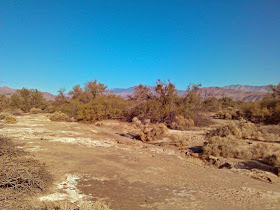 |
| Abert's Towhee. Salton Sea NWR, Calipatria, California. December 26, 2014. Greg Gillson. |
|
It had been 30 years and 2 months since I last had seen the black-faced Abert's Towhee. Guess what? It was right here on the south end of the Salton Sea.
It was October 6, 1984. Eldest daughter, Leslie, had just turned 4 years old only 3 weeks earlier. She and I headed out for 2 days at the Salton Sea--600 miles round trip. Leslie's mother and 2 younger sisters remained behind at home in Ventura, California. The temperature was over 100 degrees. The Salton Sea rotting smell pervaded everything, coming off the algae-bloom-strewn beach made primarily of dead fish bones. We ate cereal and sandwiches from the cooler, and slept out on the ground on a tarp at Finney Lake, watching the stars. We drove and walked, watched birds and had a wonderful time. I suspect that Leslie was too young to remember, but it is a fond father-daughter memory for me. (I'm hoping that Marlene doesn't remember, being left behind, as she was, with a 2 year old and newborn. I was only 26--What did I know? At least I think we were in an apartment then, and not still in the school bus we lived in for a year on the beach.)
So here I was on December 26, 2014, a mere 30 years after my last visit. This time with Marlene on a 4-day driving vacation. We had spent the previous night and this morning in Borrego Springs in eastern San Diego County. After lunch we drove farther east through the desert into Imperial County to Brawley at the south end of the Salton Sea.
By 1:30 pm we were driving north from Brawley on Lack Rd, past irrigated fields of spinach, cauliflower, onions, and broccoli. At one smoothly plowed and disced field I spied about 65 pale Killdeer-looking shorebirds way out in the field, about 1/4 mile distant. Good and bad. My life Mountain Plovers, but so far away I really couldn't make out field marks--I mean, really, how could I explain to someone why they weren't Black-bellied Plovers? Not how you want a life bird.
 |
| Snow Goose. Salton Sea NWR, Calipatria, California. December 26, 2014. Greg Gillson. |
Slowly driving the farm fields we spotted over 500 Snow and 50 Ross's geese. There was even one blue-phased Snow Goose. Cattle Egrets were plentiful. One field had about 45 Sandhill Cranes.
 |
| Gambel's Quail. Salton Sea NWR, Calipatria, California. December 26, 2014. Greg Gillson. |
At 3 pm we finally entered the parking lot of the Visitor Center at Sonny Bono Salton Sea National Wildlife Refuge (it's hard to get
this image out of my mind). That's where I photographed the Abert's Towhee that begins this article. The Abert's Towhees were at the bird feeders with Mourning Doves, Common
Ground-Doves, and Gambel's Quail. Oh, and a newly naturalized species
which wasn't present in 1984--the Eurasian Collared-Doves.
 |
| Common Ground-Dove. Salton Sea NWR, Calipatria, California. December 26, 2014. Greg Gillson. |
Just before dusk we drove down Garst Rd to the Red Hill Marina....
 |
| This rubble is all that's left of Red Hill Marina--a once rather famous birding location. December 26, 2014. Greg Gillson. |
The Salton Sea was created accidentally in 1905 by a breach in an
irrigation canal bringing water from the Colorado River into this
valley. It took 2 years to stop the breach. During that time all the
water of the Colorado River flowed into this low sink, 277 feet below
sea level, and created this lake, 35 miles long and 15 miles wide.
The Salton Sea was a popular vacation spot in the 1950's, but the hot sun and fertilizer run-off from the farm fields, regularly created algae blooms that sucked all the oxygen out of the water, causing mass die-offs of fish,... and a stink that eventually turned all the vacation resorts into ghost towns.
And, evidently, the Red Hill Marina also succumbed to lowering water levels and fewer and fewer visitors. There is a 14-day stay free county park here; but it looks like most of the residents are more or less permanent campers.
The Salton Sea is dying. Each year this lake increases its salt content by 1% from irrigation runoff. Already it is saltier than the Pacific Ocean. In a few years it will be too salty for any fish to live. And the lake is evaporating faster than water is entering. Fresh water from the Colorado River into the Sea is supposed to be suspended in 2017, and the lake is expected to shrink rapidly. Plans are being made for a very small fresh-water Salton Sea in the north and salt marshes in the south by 2035. Some are fighting to save the Salton Sea. But it is very likely that it will soon be a very different place.
There were still birds to be found along the canals and shore of the Salton Sea on the way in to the former Red Hill Marina. There were 5000 Ring-billed Gulls, and lots of Double-crested Cormorants and many ducks. A Greater and Lesser Yellowlegs were standing side-by-side on one dike for comparison.
 |
| Herring Gull. Red Hill, Salton Sea, Calipatria, California. December 26, 2014. Greg Gillson. |
We spent the night back south 10 miles at Westmorland at a very fine
Americas Best Value Inn. Then we had a nice steak dinner at the
Town Pump Steakhouse.
Then we made our plans for Day 2....
Continue on to Day 2,
here.



